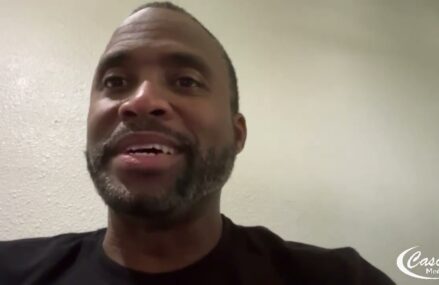By HYUNG-JIN KIM and FOSTER KLUG
FILE – In this June 27, 2008 file photo from television, the 60-foot-tall cooling tower is seen before its demolition at the main Nyongbyon reactor complex in Nyongbyon, also known as Yongbyon, North Korea. North Korea vowed Tuesday, April 2, 2013, to restart a nuclear reactor that can make one bomb’s worth of plutonium a year, escalating tensions already raised by near daily warlike threats against the United States and South Korea. The North’s plutonium reactor was shut down in 2007 as part of international nuclear disarmament talks that have since stalled. The declaration of a resumption of plutonium production — the most common fuel in nuclear weapons — and other facilities at the main Nyongbyon nuclear complex will boost fears in Washington and among its allies about North Korea’s timetable for building a nuclear-tipped missile that can reach the United States, technology it is not currently believed to have. (AP Photo/APTN, File)
SEOUL, South Korea (AP) — North Korea said Tuesday it will restart its long-shuttered plutonium reactor and increase production of nuclear weapons material, in what outsiders see as its latest attempt to extract U.S. concessions by raising fears of war.
A spokesman for the North’s General Department of Atomic Energy said scientists will quickly begin “readjusting and restarting” the facilities at its main Nyongbyon nuclear complex, including the plutonium reactor and a uranium enrichment plant. Both could produce fuel for nuclear weapons.
The reactor began operations in 1986 but was shut down as part of international nuclear disarmament talks in 2007 that have since stalled. North Korea said work to restart the facilities would begin “without delay.” Experts estimate it could take anywhere from three months to a year to reactivate the reactor.
The announcement will boost concerns in Washington and among its allies about North Korea’s timetable for building a nuclear-tipped missile that can reach the United States, although it is still believed to be years away from developing that technology.
The nuclear vows and a rising tide of threats in recent weeks are seen as efforts by the North to force disarmament-for-aid talks with Washington and to increase domestic loyalty to young North Korean leader Kim Jong Un by portraying him as a powerful military commander.
Hwang Jihwan, a North Korea expert at the University of Seoul, said the North “is keeping tension and crisis alive to raise stakes ahead of possible future talks with the United States.”
“North Korea is asking the world, ‘What are you going to do about this?'” he said.
The unidentified North Korean atomic spokesman said the measure is meant to resolve the country’s acute electricity shortage but is also for “bolstering up the nuclear armed force both in quality and quantity,” according to a statement carried by the official Korean Central News Agency.
The statement suggests the North will do more to produce highly enriched uranium. Uranium worries outsiders because the technology needed to make highly enriched uranium bombs is much easier to hide than huge plutonium facilities. North Korea previously insisted that its uranium enrichment was for producing electricity — meaning low enriched uranium.
Kim Jin Moo, a North Korea expert at the Korea Institute for Defense Analyses in South Korea, said that by announcing it is “readjusting” all nuclear facilities, including the uranium enrichment plant, North Korea “is blackmailing the international community by suggesting that it will now produce weapons-grade, highly enriched uranium.”
U.N. Secretary-General Ban Ki-moon said Tuesday that North Korea appears to be “on a collision course with the international community.” Speaking in Andorra, the former South Korean foreign minister said the crisis has gone too far and international negotiations are urgently needed.
China, North Korea’s only major economic and diplomatic supporter, expressed unusual disappointment with its ally. “We noticed North Korea’s statement, which we think is regrettable,” Chinese Foreign Ministry spokesman Hong Lei said. South Korea also called it “highly regrettable.”
The North’s plutonium reactor produces spent fuel rods laced with plutonium and is the core of Nyongbyon. It was disabled under a 2007 deal made at now-dormant aid-for-disarmament negotiations involving the North, the U.S., South Korea, Japan, China and Russia.
In 2008, North Korea destroyed the cooling tower at Nyongbyon in a show of commitment, but the deal later stalled after the North balked at allowing intensive international fact-checking of its past nuclear activities. North Korea pulled out of the talks after international condemnation of its long-range rocket launch in April 2009.
North Korea “is making it clear that its nuclear arms program is the essence of its national security and that it’s not negotiable,” said Sohn Yong-woo, a professor at the Graduate School of National Defense Strategy of Hannam University in South Korea.
North Korea conducted its third nuclear test in February, prompting a new round of U.N. sanctions that have infuriated its leaders. It has since declared that the armistice ending the Korean War in 1953 is void, shut down key military phone and fax hotlines with Seoul, threatened to launch nuclear and rocket strikes on the U.S. mainland and its allies and, most recently, declared at a high-level government assembly that making nuclear arms and a stronger economy are the nation’s top priorities.
The Korean Peninsula technically remains in a state of war because a truce, not a peace treaty, ended the Korean War. The United States stations 28,500 troops in South Korea as a deterrent to North Korea.
Washington has said it takes the threats seriously, though White House press secretary Jay Carney said Monday the U.S. has not detected any military mobilization or repositioning of forces in North Korea.
The North’s rising rhetoric has been met by a display of U.S. military strength, including flights of nuclear-capable bombers and stealth jets at annual South Korean-U.S. military drills that the allies call routine but that North Korea claims are invasion preparations.
South Koreans are familiar with provocations from the North, but its rhetoric over the last few weeks has raised worries.
“This is a serious concern for me,” said Heo Jeong-ja, 70, a cleaning lady in Seoul. “The country has to stay calm, but North Korea threatens us every day.”
North Korea added its 5-megawatt plutonium reactor to its nuclear complex at Nyongbyon in 1986, and the country is believed to have exploded plutonium devices in its first two nuclear tests, in 2006 and 2009.
There had long been claims by the U.S. and others that North Korea was also pursuing a secret uranium program. In 2010, the North unveiled to visiting Americans a uranium enrichment program at Nyongbyon.
Analysts say they don’t believe North Korea currently has mastered the miniaturization technology needed to build a warhead that can be mounted on a missile, and the extent of its uranium enrichment efforts is also unclear.
Scientist and nuclear expert Siegfried Hecker, one of the Americans on the 2010 visit to Nyongbyon, has estimated that North Korea has 24 to 42 kilograms of plutonium — enough for perhaps four to eight rudimentary bombs similar to the plutonium weapon used on Nagasaki in World War II.
It’s not known whether the North’s latest atomic test, in February, used highly enriched uranium or plutonium stockpiles. South Korea and other countries have so far failed to detect radioactive elements that may have leaked from the test and which could determine what kind of device was used.
___
Associated Press writers Sam Kim and Jean H. Lee in Seoul, John Heilprin in Geneva, and researcher Zhao Liang in Beijing contributed to this report.



